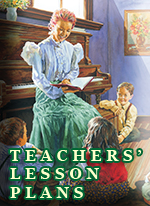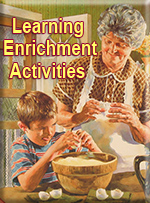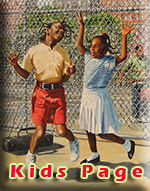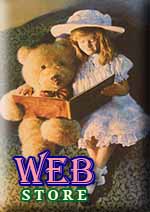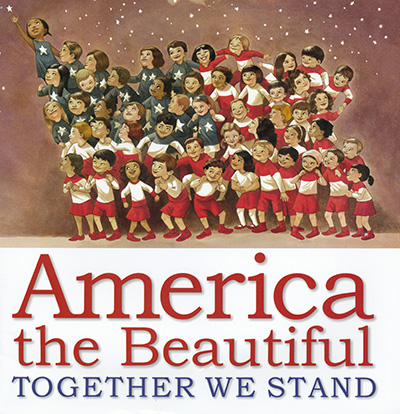|

ABOUT THIS BOOK:
With spirited pictures, ten distinguished children's book artists interpret the popular song "America the Beautiful." Inspiring presidential quotes paired with the artwork deepen our experience of this beloved patriotic song.

 |
“America the Beautiful” first appeared in print in the weekly journal The Congregationalist, on July 4, 1895. The lyrics were written while on an 1893 summer lecture series at Colorado College in Colorado Springs.
Looking at the view of the Rockies from Pikes Peak, its author, Katharine Lee Bates recalls, "It was then and there, as I was looking out over the sea-like expanse of fertile country spreading away so far under those ample skies, that the opening lines of the hymn floated into my mind. When we left Colorado Springs the four stanzas were penciled in my notebook, together with other memoranda, in verse and prose, of the trip. The Wellesley work soon absorbed time and attention again, the notebook was laid aside, and I do not remember paying heed to these verses until the second summer following, when I copied them out and sent them to The Congregationalist, where they first appeared in print July 4, 1895. The hymn attracted an unexpected amount of attention. It was almost at once set to music by Silas G. Pratt. Other tunes were written for the words and so many requests came to me, with still increasing frequency, that in 1904 I rewrote it, trying to make the phraseology more simple and direct."
In addition to simplifying the phrasing and text, Bates made one change in the wording of the third stanza adding “beautiful”. The new version was published in The Boston Evening Transcript on November 19, 1904. While the poem was sung with a variety of tunes, it has almost exclusively adapted Samuel A. Ward’s “Materna” as its melody.
Katharine Lee Bates was born on August 12th, 1859 in Falmouth, Massachusetts. Moving to Wellesley as a child, she attended Wellesley high school graduating in 1874. She continued her education at Newton High school and then entered Wellesley College graduating with a Bachelor of Arts degree from Wellesley College in 1880. From 1880 to 1925, Bates taught at Wellesley College as a professor of English Literature. She also studied at Oxford and earned a masters degree in arts from Wellesley.
Bates was a noted scholar, poet and writer. She was a prolific author publishing many volumes of poetry, books on her travels to Europe and the Middle East and stories, verses and plays for children. She also published several books on Shakespeare and pre-Shakespearean English Religious drama.
In 1915, Bates was a founder of the New England Poetry Club and served as its president. She was involved in social reform activities, working for labor reform and planning the College Settlements Association with Vida Scudder. Bates lived for 25 years with Katharine Coman. She never married and had no children. In 1925, Bates retired and spent the remaining years in Wellesley. Katherine Lee Bates died on March 28, 1929.
Bates remarked on the immediate and lasting success of the song stating: “That the hymn has gained, in these twenty odd years, such a hold as it has upon our people, is clearly due to the fact that Americans are at heart idealists, with a fundamental faith in human brotherhood. |
PUBLISHERS WEEKLY: Yuyi Morales, Jon J Muth, and LeUyen Pham are among 10 top-drawer illustrators that form a more perfect union of sorts, interpreting lines from Bates's popular patriotic song; each spread also features a stirring quote from a famous American. Some artists take a direct approach: Harry Potter illustrator Mary GrandPre, who has "For amber waves of grain," and a quote from Thomas Jefferson ("I believe... that every human mind feels pleasure in doing good to another") shows a trio of children in a radiant field of grass, turning a weathered tree trunk into a literal prairie schooner. Sonia Lynn Sadler, one of several artists that go the mural route, contributes the book's most striking and least literal image; she uses "Above the fruited plain" (paired with the opening of the Gettysburg Address) to imagine a quilting bee where Americans of all ages and backgrounds stitch together patches celebrating the nation's greatest hits (the Statue of Liberty, the St. Louis arch, the space shuttle), a smart outlet for her folk-art style. A visually rich and much-needed reminder of America's collective resilience. All ages. (Jan.) (c) Copyright PWxyz, LLC. All rights reserved.
|
SCHOOL LIBRARY JOURNAL: K-Gr 5-When illustrations from 10 prominent children's book artists are combined with the words from Bates's "America the Beautiful" and quotations from a range of United States presidents, the result is a beautiful, patriotic ode to the best of our nation. This multifaceted concept is elegantly executed in a book that will be useful to anyone seeking to engage children in learning more about American history, landmarks, and symbols. Words from Jimmy Carter set the tone, saying, "We become not a melting pot but a beautiful mosaic. Different people, different beliefs, different yearnings, different hopes, different dreams." Each illustration, masterfully rendered by artists such as Yuyi Morales, Jon J Muth, LeUyen Pham, and Chris Soentpiet, among other stars, depicts a multiethnic, multicultural view of the possibilities America represents. The book design successfully integrates the various elements. Pictorial spreads leave one panel open for the quotations, while Bates's words appear in large type at the bottom or top of each illustration. The quotations all focus on helping others and being our best selves, individually and as a country. In a time when political debate is sharply divided, this book reminds us that some ideals are part of our national heritage and stand above the disagreements.-Lucinda Snyder Whitehurst, St. Christopher's School, Richmond, VA (c) Copyright 2013. Library Journals LLC, a wholly owned subsidiary of Media Source, Inc. No redistribution permitted.
|
| KIRKUS: What better way to make this patriotic song meaningful to kids than with these lively illustrations by 10 different illustrators? Each spread portrays a line or phrase from the song with a sidebar quote from a president (cherry-picking from Washington to Obama). For "For amber waves of grain," Mary GrandPr depicts three kids and a dog pretending to be sailing on a boat that's a dead tree amid a field of wheat; this is paired with a quote from Thomas Jefferson: "I believethat every human mind feels pleasure in doing good to another." An interior spread ("with brotherhood") by LeUyen Pham repeats the cover, picturing kids wearing red-and-white striped outfits representing the flag's stripes and kids in blue sweaters with stars completing the flag. The quote is from Theodore Roosevelt: "Keep your eyes on the stars, but remember to keep your feet on the ground." The other illustrators are Diane Goode, Jon J Muth, Yuyi Morales, John Hendrix, Bryan Collier, Chris Soentpiet, Ral Colon and Sonia Lynn Sadler. Handsomely designed, this is a beautiful tribute to America and Americana. (selected national landmarks and symbols, biographical note, song lyrics, definition of democracy) (Picture book. 5-9)]] Copyright Kirkus Reviews, used with permission. |
Theme: By using the book AMERICA THE BEAUTIFUL students can map the location of events and places that contributed to the creation of the national hymn. This book can be used for holidays such as Memorial Day, Fourth of July, Labor Day, Election Day, Veteran's Day, Flag Day.
Common Core Standard/s: Know the histories of important local and national landmarks, symbols, and essential documents that create a sense of community among citizens and exemplify cherished ideals (e.g. the U.S. flag, the bald eagle, the Statue of Liberty, the U.S. Constitution, the Declaration of Independence, the U.S. Capitol).
Pre-reading: Show the students the cover of the book, read the title, author
and illustrator's name. Ask them what they think the book will be
about. Have the students look at a globe or world map to
locate where they are on the United States map.
Reading: As you read and show the illustrations have the students look
closely at the drawings. What details can they find in the pictures?
Have them look closely at the expressions on the faces for the characters. Ask the students how they
think the characters are feeling. Can they tell by the illustrations?
Writing: Ask students if they ever attended an event or visited a place that inspired them. They can write about it their experience.
Geography: Tell students that they will begin to design their neighborhood maps as homework. Each map should be designed as a square, with a student's home at the center. Tell students to walk a block or two north, south, east, and west of their home, taking notes on what they see in all directions (houses, parks, businesses, buses, trains, types of vegetation and terrain, etc.). Encourage students to make sketches of what they see. Students unable to complete maps of their own neighborhoods may make one of the neighborhood around the school.
Social Studies: To better understand and apply the rights and responsibilities of citizenship in the United States, students will interview their fellow classmates on a given point and use the information to make a bar graph, charts to illustrate the differences within the classroom in order to develop an understanding of and respect for diversity. The use of tools of social science inquiry (such as surveys, statistics, maps).
Language:
Literature: Read AMERICA by Lynne Cheney, AMAZING FACES by Lee Bennett Hopkins, THE STORY OF THE STAR SPANGLED BANNER by Patricia A. Pingry, F IS FOR FLAG by Wendy Cheyette Lewison, THE FOURTH OF JULY STORY by Alice Dalgliesh. If you really enjoyed AMERICA THE BEAUTIFUL write a review and post it on-line at Amazon.com or Barnesandnoble.com so others can enjoy your reading experience.
Art: Each president had a unique vision of America. In AMERICA THE BEAUTIFUL, these visions are translated into different style of illustrations by such top artists as Bryan Collier, Jon J Muth, Diane Goode, Mary GrandPre, Raul Colon, Sonia Lynn Sadler, Yuyi Morales, John Hendrix, LeUyen Pham and Chris Soentpiet. Each of these illustrators has found a unique way to interpret the values and beliefs that have built our great country. Talk about different art techniques. What medium did the artist use (watercolors, acrylic, oil, airbrush, charcoal pencils/sticks). Explain the difference between abstract and realism by comparing the art style of the different artists.
Bulletin
Board -Display the students writing and geography lessons on your bulletin board. |

